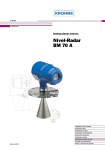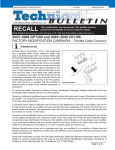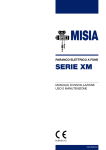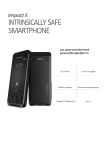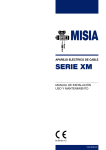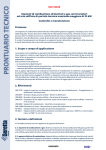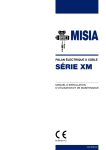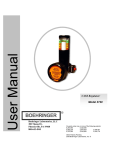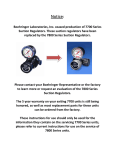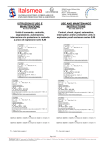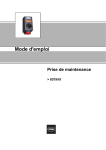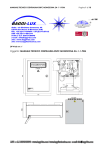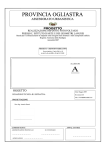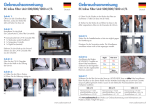Download VIS explosion proof brake operations manual Motion Technologies
Transcript
Explosion-Proof Brakes series VIS II 63…280 REV Manuale di uso e manutenzione Operating and maintenance manual 1. PREMESSA Queste istruzioni di sicurezza si riferiscono all’installazione, uso e manutenzione del freno elettromagnetico VIS II antideflagrante, certificato per uso in aree con presenza di atmosfere potenzialmente esplosive. Il freno VIS II Generazione è costituito da una custodia e una scatola morsettiera in Ghisa sferoidale normalizzata per le basse temperature. E sono realizzati in tredici modelli differenti: VIS II 63 / 71 / 80 / 90 / 100 / 112 / 132 / 160 / 180 / 200/ 225 / 250 /280 I freni della serie VIS II sono costruiti in accordo alla direttiva ATEX 94/9/CE – ATEX 95, gruppo II, categoria 2GD o Gruppo I categoria I M2, in conformità alle norme EN 60079-1:2007, EN 60079-0:2009, EN 60079-31:2009. nelle seguenti versioni: Categoria: 2G / 2D / 2GD / I M2 Modo di protezione: Ex d / Ex tb IIIC Gruppo di gas: II B / II C / I Classe di temperatura: T3 / T4 / T5 o < 150°C per gruppo I Temperatura massima superficiale: T200°C / T135°C / T100°C Grado di protezione IP66 e Temperatura ambiente -50°C / +55°C (T5 +60°C)dal 63 al 225 e per il tipo 250/280 -20°C / +55°C (T5 +60C°). 2.CARATTERISTICHE TECNICHE Il freno elettromagnetico VIS II è del tipo negativo a disco. All'interno del gruppo freno è situato un disco frenante capace di scorrere assialmente all’albero che lo trascina,l’ancora mobile e un elettromagnete hanno il compito di bloccare il freno;in assenza di corrente l’ancora è spinta dalle molle verso il disco freno che dall’altro lato troverà una piastra d’attrito,determinando il blocco dell’albero;in presenza di corrente,l’elettromagnete,attrae a sé l’ancora mobile liberando il disco e permettendo la rotazione dell’albero. Attenzione:I freni VISII devono essere accoppiati ad apparecchiature oggetto di certificazione ATEX separata con marcatura compatibile.L’accoppiamento è realizzato con flangie ed alberi d'attacco in ingresso ed uscita unificate secondo IEC 60034-1 dalla taglia 63 alla 280, oppure con varianti d'accoppiamento speciali o secondo altre unificazioni meccaniche (ad esempio NEMA). 3. MARCATURA La marcatura prevista per i freni serie VIS è la seguente: Marcatura per miniere-Marking for mining : I M2 Ex d I Mb Tamb. : -50°C 0051 Tamb +60°C). Marcatura per gas-Marking for gas : 55°C (T5 Tamb +60°C) or -20°C II 2 G Ex d II P 1 T P 2 Gb Tamb. : -50°C 0051 55°C (T5 Tamb +60°C). Marcatura per polveri-Marking for dust : 2 May 2013 1. INTRODUCTIONS These safety instructions refer to the installation, operation and maintenance of the VIS II flameproof brake, certified for use in areas where there is a presence of potentially explosive atmospheres. They are made up of a case and a terminal box in cast iron. The VIS II brakes are explosion proof made and they are manufactured in thirteen models: VIS II 63 / 71 / 80 / 90 / 100 / 112 / 132 / 160 / 180 / 200 / 225 / 250 / 280 The VIS series brakes are designed following the ATEX Directive ATEX 94/9/CE-ATEX 95,Group II, 2GD category or Group I category I M2, in compliance with the norms EN 60079-1:2007, EN 60079-0:2009, EN 60079-31:2009. All brakes Atex are available in the following versions: Category: 2 G / 2D / 2GD / I M2 Type of protection: Ex d / Ex tb IIIC Enclosure group: II B / II C / I Temperature class: T3 / T4 / T5 o < 150°C for Group I Maximum surface temperature: T200°C / T135°C / T100°C Protection mode IP66 and Ambient temperature -50°C/+55°C(T5 +60°C from frame 63 up to frame 225 while frame 250/280 temperature is -20°C / +55°C. 2.MAIN CHARACTERISTICS The electromagnetic brake VIS II is a negative disc brake type. Inside the brake group there is a braking disc in a position to sliding axially on the shaft and to be dragged by the same shaft, an electromagnet and a mobile anchor. When there is no current, the mobile anchor is pushed against the brake disc from the springs, this brake disc is pushed to another friction surface on the other side, in this way the shaft cannot rotate. In current presence, the electromagnet attracts to himself the mobile anchor freeing the disc and allowing of the rotation. The brake must be coupled to a component, already having a separate and compatible ATEX certification. Mounting with input or output flanges and shafts is in compliance to IEC60034-1 from frame 63 up to 280. Special mounting or other mechanical standards (as an example NEMA) could be manufactured. 3. MARKING The VIS brake’s nameplate shows the following information : 55°C (T5 55°C (T5 Tamb +60°C) or -20°C GRANDEZZA FRAME II 2 D Ex tb IIIC T P 3 Db IP66 Tamb. : -50°C 55°C (T100°C Tamb +60°C)or 0051 -20°C 55°C (T100°C Tamb +60°C). Marcatura per gas e polveri-Marking for gas and dust : II 2 GD Ex d II P 1 T P 2 Gb Ex tb IIIC T P 3 Db IP66 Tamb. : -50°C 55°C (T5 or T100°C Tamb +60°C) or -20°C 55°C (T5 or T100°C Tamb +60°C). 0051= numero organismo notificato sorveglianza ATEX(IMQ) -number organism notified surveillance ATEX(IMQ) II= gruppo II (superfice)-group II (superficial) Le posizioni Pn prevedono le varianti costruttive -The position Pn they preview constructive varying: P1 indica il gruppo di gas,se-P1 it indicates the group of gas: P1=B:gruppo di gas IIB-group of gas IIB. P1=C:gruppo di gas IIC-group of gas IIC. P2/P3 indica le classi di temperatura/temperatura Max superficiale,se-P2/P3 it indicates the classes of temperatures/superficial temperature max,if: P2=T3 P3=T200°C P2=T4 P3=T135°C P2=T5 P3=T100°C IP66= grado di protezione-protection degree. -50°C/+55°C (T5 or T100°C Tamb +60°C) (type250/280Tamb-20°C/+50°C (T5 or T100°C Tamb +60°C))= temperatura ambiente-ambient temperature. T.cable80°C= temperatura del cavo-temperature of the cable. 0051 INERIS 06 ATEX 0047X www.visbrakes.com MARCATURA MARKING 0051 Type VISII NUMERO MATRICOLA SERIAL NUMBER TENSIONE NOMINALE NOMINAL VOLTAGE ID Size V Hz V Hz A IP66 S A Tcable 80°C Nm Tamb WARNING: Do not open when energized if any explosive atmosphere may be present - Screws quality minimun 12.9(UNI 3740-74) Manufacturer Coel Motori - 20090 - Fizzonasco (Milano) ITALY CORRENTE NOMINALE NOMINAL CURRENT MODELLO FRENO TYPE OF VIS BRAKE SERVIZIO DUTY COPPIA FRENANTE BRAKING TORQUE TEMPERATURA AMBIENTE AMBIENT TEMPERATURE RANGE FREQUENZA NOMINALE NOMINAL FREQUENCY 1 I freni, sono progettati per essere accoppiati a componenti, oggetto di certificazione ATEX separata con marcature compatibile, con servizio S1 (continuo) o intermittente S2, S3 o S4. I freni VIS II sono adatti a sopportare cicli orari di avviamento e frenatura continui secondo i valori riportati nella seguente tabella: Modello Avv./h (max) Nm (max) 63/71 1800 8 80/90 1800 22 100/112 1300 60 132/160 900 180 180/225 600 460 250/280 600 2000 The brakes are designed to be applied to a component, covered by separated Atex certification, with S1 duty (continuous) or S2, S3, S4 duty (intermittent). All the VIS brake types are designed to work at the following starting and braking duty cycles: In caso di momento d’inerzia applicato, tale da determinare uno slittamento del disco freno per un tempo compreso tra 1 e 1,5 secondi, i cicli di frenatura massimi ammessi sono i seguenti: Modello Avv./h (max) Nm (max) 63/71 1200 8 80/90 1200 22 100/112 900 60 132/160 300 180 180/225 200 460 250/280 200 2000 I valori di coppia frenante massima dichiarati si intendono statici. Tutte le parti accoppiate al freno VIS II (meccaniche pneumatiche o idrauliche) ed in grado di generare una scintilla o un punto caldo, devono essere in accordo alla Direttiva ATEX 94/9/CE. 4. ISTRUZIONI DI SICUREZZA PER ZONE PERICOLOSE. Prima della messa in servizio, l’utilizzatore deve verificare che la costruzione elettrica sia appropriata alla classificazione del luogo pericoloso (Zone 1, 2, 21, 22); e verificare che il gruppo e la classe di temperatura della costruzione elettrica siano appropriate all’area pericolosa. I freni forniti sono pronti per l’utilizzo secondo le caratteristiche definite in fase d’ordine. Se fossero richieste coppie frenanti, cicli di lavoro ed inerzie differenti da quanto definito in fase d’ordine, contattateci. I freni serie VIS II devono essere installati e mantenuti in accordo con le norme impiantistiche e di manutenzione per gli ambienti a rischio di esplosione EN 60079-14, EN 60079-17, EN 61241-17 I freni VIS II possono essere forniti con elettromagnete AC o DC. Tensione di alimentazione compresa tra 24 V e 690 V (AC); 24 V a 300 V (DC). Frequenza 50/60 Hz. Classe di isolamento F. Utilizzare solo cavi con temperature di esercizio di 80°C e entrate cavo, oggetto di certificazione ATEX – Si raccomanda l’uso di pressa cavi con membrana interna in materiale composito. USARE VITI DI QUALITÀ MINIMA A12.9. AVVISO: NON APRIRE IN PRESENZA DI ATMOSFERA ESPLOSIVA. DOPO OGNI APERTURA RIPRISTINARE IL GRASSO SUI GIUNTI. UTILIZZARE SOLO GRASSO BIANCO AL LITIO. In presenza di polveri combustibili si deve limitare la formazione di depositi di polvere a 5 mm di spessore. 4.1. AVVERTENZE GENERALI SULLA SICUREZZA Un uso improprio, la carenza di ispezioni e manutenzioni, possono causare gravi danni a persone o cose. Il personale deve essere informato del pericolo dal contatto con parti in tensione, parti rotanti e superfici calde (in condizioni normali di funzionamento il freno può superare i 50 °C). Il freno VIS II deve essere movimentato, installato, messa in servizio, ispezionato, manutentato e riparato esclusivamente da personale qualificato. Il freno VIS II è un componente che viene meccanicamente accoppiato ad un'altra macchina. E’ pertanto responsabilità di chi esegue l'installazione garantire che durante il servizio ci sia, per le persone o le cose, un adeguato grado di protezione contro il pericolo di contatti accidentali con parti in movimento. 5. STOCCAGGIO I freni vengono spediti pronti per l'installazione. Al ricevimento occorre rimuovere l'imballo e verificare, che il freno non abbia subito danni e sia completo di tutti gli eventuali accessori. Nel caso si riscontrassero dei danneggiamenti è necessario contattare Coel entro 3 giorni. In caso di immagazzinamento, i freni devono essere conservati in luogo asciutto, privo di polveri, vibrazioni, gas e fumi corrosivi, con temperatura uniforme. La temperatura di stoccaggio dei freni deve essere compresa tra 5°C e 45°C, con umidità relativa non superiore al 60%. Il periodo di immagazzinamento non deve essere superiore a 18 mesi. In case of a applied moment of inertia determines a sliding of the brake disc from 1sec. to 1,5sec., the admitted maximum cycles are following: 6. ISTALLAZIONE ATTENZIONE: I lavori sul freno VIS II devono avvenire a macchina ferma e scollegata elettricamente dalla rete (compresi gli ausiliari). Adeguate precauzioni devono essere prese per evitare sovratensioni o picchi di tensione. I cavi non devono essere schiacciati o soggetti a carichi meccanici. Impiegare cavi aventi sezione sufficiente per sopportare la corrente massima assorbita evitando surriscaldamenti e/o cadute di tensione. Collegare i cavi ai morsetti come negli schemi di collegamento in seguito illustrati. Verificare che i dadi dei morsetti siano ben stretti. Le connessioni ai morsetti devono essere eseguite in modo da garantire le distanze di sicurezza tra parti nude in tensione. Le superfici di contatto delle connessioni devono essere pulite e protette dalla corrosione. 6. INSTALLATION WARNING: Work on the VIS II brake must be carried out when the machine has stopped and been disconnected from the power supply (including auxiliary parts). Adequate precautions must be taken to avoid excess voltages or peak voltages. The cables must not be crushed or exposed to mechanical loading. Use cables with sufficient section to bear the maximum current absorbed, avoiding overheating and/or drops in voltage. Connect the cables to terminals by following the instructions on the following diagrams. Check that terminal nuts are tightened. Connections to the terminals must be made in order to guarantee safe distances between live uncovered parts. The area of contact of connections must be cleaned and protected against corrosion. Type 63/71 80/90 100/112 132/160 180/225 250/280 start/h (max) 1800 1800 1300 900 600 600 Nm (max) 8 22 60 180 460 2000 Type start/h (max) Nm (max) 63/71 1200 8 80/90 1200 22 100/112 900 60 132/160 300 180 180/225 200 460 250/280 200 2000 The values of the braking torques are static. All the devices coupled to the VIS II brake (mechanics, pneumatic or hydraulic) in a position to generate a spark or a hot spot, must be object of risk analysis in agreement to Directive ATEX 94/9/CE. 4. SAFETY INSTRUCTION FOR HAZARDOUS AREAS Before using, the user has to verify that the VIS II brake is intended for operation in hazardous areas (Zones 1, 2, 21, 22); to verify that his group and the temperature class comply with the area rating. The brakes are supplied ready for use, according to the specifications indicated in the order. If any braking torques, work cycles, or inertias differ from those indicated in the order are required, please contact us. VIS series brakes must be installed and maintained following the norms for plants and of maintenance in explosive locations: EN 60079-14, EN 60079-17, EN 61241-17 The VIS II brakes can be supplied with AC three phase or DC single phase electromagnets. Supply tension included between 24V and 690V (AC), 24 V and 300 V (DC). Frequency 50/60 Hz . Insulation class F. Use cable with temperature range of 80°C and cable glands with separated ATEX certification only – we recommend to use cable glands with internal compound seal. USE SCREWS OF MINIMUM QUALITY A12.9. WARNING: DO NOT OPEN IF EXPLOSIVE ATMOSPHERES ARE PRESENT. AFTER OPENING PUT AGAIN GREASE ON THE JOINTS. USE ONLY LITHIUM WHITE GREASE. If combustible dust are present, the user must supply keep the brake clean in order to avoid the dust storing up 5 mm thick. 4.1. GENERAL SAFETY WARNINGS Improper use, lack of inspection and maintenance can cause serious harm. The personnel must be informed of any danger caused by contact with live parts, rotating parts and hot surfaces. In normal working conditions the brake exceeds 50°C. The VIS II brake must be moved, installed, put in service inspected, maintained and repaired only by qualified personnel. The VIS brake is a component made to be mechanically connected to another machine. Consequently, it is the task of the person responsible for the installation to guarantee that during operation there is an adequate degree of protection for people or things against the danger of accidental contact with moving parts. 5. STORAGE The brakes are shipped ready for installation. Upon receipt remove packaging and check the brake has not been damaged. In the case where the brake is damaged an immediate notification must be given to Coel within 3 days. In storing case, the brakes must be conserved in dry place, lacking in powders, vibrations, gas and corrosive smoke, with uniform temperature. The temperature of the brakes stocking place must be between 5°C and 45°C, with relative humidity not over 60%. The storing time does not have to be longer than 18 months. 2 Collegamenti di terra: Sono previsti due collegamenti di terra, uno all’interno della scatola morsetti ed uno esterno situato sulla carcassa del freno. Entrambi devono essere collegati alla terra generale dell’impianto con un conduttore di sezione adeguata. Richiudendo la morsettiera occorre ripristinare lo strato di grasso. Il coperchio della scatola morsettiera va stretto a fondo per una buona tenuta. 6.1. MESSA IN SERVIZIO E’ responsabilità dell'impiantista stabilire l'idoneità del freno ad essere utilizzato in un determinato impianto, dopo aver analizzate le caratteristiche di pericolo esistenti nell'area di installazione e nel rispetto delle vigenti disposizioni legislative e di quelle emesse ai fini della sicurezza. Accertare che il freno sia idoneo al funzionamento nelle condizioni di esercizio previste in sede d'ordine. Prima della messa in marcia del freno, è indispensabile verificare che: l'installazione sia stata effettuata in modo corretto i cuscinetti non abbiano subito danni durante l'accoppiamento i dati di progetto corrispondono a quelli indicati sulla targa e sulla documentazione tecnica. 7. MANUTENZIONE Il freno VIS II è progettato in modo da evitare difficili operazioni di manutenzione. Le verifiche e la manutenzione sui freni antideflagranti VIS II devono essere effettuate secondo i criteri della norma EN 60079-17, mentre le riparazioni secondo i criteri specificati dalla norma IEC 60079-19. NON SONO AMMESSE MODIFICHE NON AUTORIZZATE DAL COSTRUTTORE; IN CASO CONTRARIO DECADE LA GARANZIA E LA RESPONSABILITÀ DEL COSTRUTTORE. Nel caso di riparazioni su parti influenti ai fini della protezione contro il rischio di esplosione non devono essere modificati i dati costruttivi del freno (ad esempio: dimensioni dei giunti, caratteristiche dei cuscinetti, ecc.) e nel caso di sostituzione di componenti questi devono essere originali. Il tipo di manutenzione e la frequenza dei controlli dipendono dalle condizioni ambientali e di funzionamento. In particolare l’usura del disco freno può dipendere dall’inerzia del carico, dalla velocità di rotazione del freno o dalla frequenza degli interventi. Earthing Connections: Two earthing connections are provided, one inside the terminal box, the other one on the brake case. Both of them must be connected to the plant earth with at least one conductor with an adequate cross sectional area. Reassembling the terminal box it is necessary to replace the ayer of grease. The terminal box cover must be tightened to ensure it is properly sealed. 6.1. PUTTING INTO OPERATION It is the responsibility of the installer to establish the brake’s fitness to be used in a certain plant, after analysing the characteristics of danger existing in the installation area with respect to current provisions of the law and to those issued for safety purposes. Make sure that the brake is suited for use in the working conditions defined in order. Before starting the brake it is important to check that: installation has been carried out properly the bearings have not been damaged during installation the design data corresponds to those given on the plate and in the technical documentation. Si consiglia di seguire periodicamente le seguenti istruzioni: a) Pulire le superfici esterne del freno e rimuovere eventuali depositi di polvere in particolare nella scatola morsettiera. b) Verificare il valore della corrente nominale. c) In caso di non funzionamento del freno, è consigliato di contattare un centro d’assistenza autorizzato per le riparazioni. Anyway, please find the following instructions: a) Periodically clean the external surface of the brakes and remove dust in particular around the terminal box. b) Check that nominal current consumption is respected. c) In case of non function of the brake, please supply to an authorized assistance workshop for repairing. 8. COLLEGAMENTI Collegare il freno secondo I seguenti schemi controllando la corrispondenza dello schema con l’indicazione riportata all’interno della scatola morsettiera: 8. CONNECTIONS Connect the brake according to the following connection diagrams checking the correspondence with the indication inside the terminal box: 7. MAINTENANCE VIS brake are designed in order to avoid difficult maintenance operations. The inspections and maintenance of flameproof VIS II brakes shall be executed in compliance with the criteria of the EN 60079-17 standard, while repairs in compliance with the criteria specified in the IEC 60079-19 standard. MODIFICATIONS NOT AUTHORIZED FROM THE CONSTRUCTOR ARE NOT ADMITTED; IN CASE OF MODIFICATIONS THE GUARANTEE AND THE RESPONSIBILITY OF THE CONSTRUCTOR IS NOT VALID. If repair work has to be performed on parts that influence the protection against explosions, the brake construction data must not be changed (for example: dimensions of joints, bearings characteristics, etc.) and if parts are replaced, this must be with original components. The type of maintenance and frequency of checks depends on the ambient and working conditions. Especially wear on the brake disc depends on various factors: load inertia, brake rotation speed, and frequency of engaging. FRENO TRIFASE-AC 3PH BRAKE A CONNESSIONE STELLA (CENTRO STELLA SU V2) STAR CONNECTION (DELTA POINT ON V2) FRENO DC - DC BRAKE D CONNESSIONE FRENO DC DC BRAKE CONNECTION L1 L2 NOTA: SE RICHIESTA VERSIONE SENZA RADDRIZZATORE APPLICARE TENSIONE DC A U2 W2 NOTE: IF VARSION WITHOUT RECTIFIER IS REQUIRED, JUST SUPPLY DC VOLTAGE TO U2 W2 L5 L4 F L3 Blue V1 U1 V2 U2 W2 W1 V1 U1 V2 U2 W2 TRM W1 L2 L3 W1 V1 U1 V2 U2 W2 TRM NOTA: I COLORI DEI TERMINALI MAGNETE DI INIZIO E FINE AVVOLGIMENTI DEVONO ESSERE POSTI SU W1-V1-U1 AVENDO CURA CHE I COLORI NON CORRISPONDANO NOTE: TERMINALS COLOURS FROM MAGNET DOESN'T HAVE TO MATCH ON ONCE CONNECTED ON W1-V1-U1 CONNESSIONE CON TERMICHE E AUSILIARI TERMINAL BOARD WITH AUXILIARY DEVICE CONNECTION C CONNESSIONE CON TERMICHE E AUSILIARI FRENO TERMINAL BOARD WITH AUXILIARY DEVICE CONNECTION L4 Blue U2 V2 U1 V1 W1 2 F W2 U2 V2 U1 V1 W1 CONNESSIONE CON TERMICHE E 2 AUSILIARI FRENO TERMINAL BOARD WITH 2 AUXILIARY DEVICE CONNECTION Blue NOTA: IN CASO DI CONNESSIONE A TRIANGOLO VEDI SCHEMA "B" NOTE: IN CASE OF DELTA CONNETCTION SEE "B" CONNECTION SCHEME 1 A U X L5 R A D Blue W2 U2 V2 U1 V1 W1 2 2 F L4 L3 NOTA: SE RICHIESTA VERSIONE SENZA RADDRIZZATORE APPLICARE TENSIONE DC A V1 W1 NOTE: IF VARSION WITHOUT RECTIFIER IS REQUIRED, JUST SUPPLY DC VOLTAGE TO V1 W1 R A D F TRM L2 Blue 1 AUX F L1 L5 W2 1 A.C.H. F E TRM CONNESSIONE TRIANGOLO DELTA CONNECTION L1 R A D F TRM B Blue AUX LEGGENDA - LEGEND TRM: THERMISTORS-TERMICHE F: MAGNET -MAGNETE RAD: RECTIFIER-RADDRIZZATORE AUX: AUXILIARY -AUSILIARI ACH: HEATER - SCALDIGLIA ANTICONDENSA L1 L2 L3: AC 3PH INPUT -INGRESSO TRIFASE L4 L5: RECTIFIER AC INPUT -INGRESSO RADDRIZZATORE AC * COLLEGAMENTO FRENATA RAPIDA RADDRIZZATORE 4440/5 E 2440/5 RECTIFIER CODE 4440/5 AND 2440/5 CONNECTION FOR FAST BRAKING RECTIFIER TRM BLU BLU RED (+) BLACK (-) WHITE (-) AC - IN MAGNET MORSETTO DELLE SONDE TERMICHE TRM VA COLLEGATO AL DISPOSITIVO DI SGANCIO A RIARMO NON AUTOMATICO. THERMISTORS TO BE CONNECTED TO THE NON-AUTOMATIC RESET DEVICE. NOTE: I FRENI VIS DC SONO EQUIPAGGIATI DI SERIE CON RADDRIZZATORE SEMIONDA TIPO WR2008 A 4 TERMINALI CON FUNZIONE DI AGGANCIO E SGANCIO RAPIDO AUTOMATICI. IN CASO DI RICHIESTA CON RADDRIZZATORE AD ONDA INTERA, IL FRENO SARA' EQUIPAGGIATO CON RADDRIZZATORE CODICE 4440/5* IN CASO DI RICHIESTA CON RADDRIZZATORE SEMIONDA CON TEMPI DI INTERVENTO STANDARD IL FRENO SARA' EQUIPAGGIATO CON RADDRIZZATORE CODICE 2440/5*. DC VIS BRAKES ARE NORMALLY EQUIPPED WITH HALF WAVE RECTIFIER HAVING 4 WIRES TYPE WR 2008 HAVING FAST ENGAGEMENT AND SWITCHING AUTOMATIC FUNCTION. IN CASE OF BRAKES REQUIRED WITH FULL WAVE RECTIFIER, BRAKES WILL BE EQUIPPED WITH RECTIFIER CODE 4440/5*. IN CASE OF BRAKES REQUIRED WITH HALF WAVE RECTIFIER WITH STANDARD ENGAGEMENT AND RELASE TIME RESPONSE, BRAKES WILL BE EQUIPPED WITH RECTIFIER CODE 2440/5*. 3 9. SBLOCCO MANUALE I freni VIS II possono essere dotati su richiesta del cliente di una leva per lo sblocco manuale. Tale sistema permette di ruotare l’albero manualmente in assenza di alimentazione. Nel tirare la leva di sblocco, raggiunto il fine corsa si deve aumentare leggermente lo sforzo fino all’avvenuto sblocco dell’albero. Aver cura a non forzare eccessivamente la leva. Riposizionando la leva al punto iniziale il freno torna alla stato di blocco. Quando il freno è dotato di sblocco manuale del freno deve essere installato in modo da impedire ogni azionamento accidentale dello sblocco e da assicurare un facile intervento di sblocco quando necessario. Se il freno VIS II è predisposto per lo sblocco manuale, sulla custodia del freno si hanno due fori opposti, ciascuno chiuso da un tappo. Per installare il dispositivo di sblocco [fig.3] bisogna, prima rimuovere i tappi dai lati della custodia antideflagrante. Poi avvitare i due perni di sblocco (N.1) per mezzo dei dadi esagonali. Sulla custodia, in prossimità del dispositivo di sblocco, sono presenti due fori (N.2), in cui fissare la molla (N.5). Fissare la leva di sblocco (N.3) nel perno di sblocco (N.4) e un’estremità della molla (N.5) nel foro (N.6) della leva per mezzo di una vite; fissare l’altra estremità della molla (N.5) nel foro (N.2) tramite un dado. 9. HAND RELEASE VIS II brake can be supplied with (or ready for) hand release lever for the brake. It allows the shaft to rotate even when the power is off. Pulling the hand release, when the end of the stroke is reached you have to increase the strain slightly until the shaft is released. Do not apply excessive force to the hand release lever. Releasing force on the mechanism the brake automatically returns to the fail safe position. When the brake is fitted with a manual brake release lever it must be installed so as to avoid any accidental activation of the release unit and ensures that it is easy to release when necessary. When the brake is ready for hand release lever [fig.3], on the brake case there are two opposite housing for release device covered by two screw plugs (N.1). To install the levers, before removing the screw plugs then screwing the release hinges (N.1) through the hexagonal nut. On the case, near the release hinges two holes thread (N.2) are presents, where fixing the spring (N.5). Fix the hand levers (N.3) in the release hinges (N.4) and then, fix an extremity of the spring (N.5) in the hole (N.6) of the release lever through a screw; clasp the other extremity of the spring (N.5) in the hole (N.2) by a nut. Dichiarazione CE di conformità EC Declaration of conformity Il costruttore: The Manufacturer: COEL Motori srl Via Campania 40 20090 – Fizzonasco di Pieve Emanuele – MI ITALY dichiara sotto la propria esclusiva responsabilità che il prodotto: declares under own sole responsibility that the product: Electromagnetic flameproof brakes types VIS II 63... – … – VIS II 280... Certificato: INERIS 06 ATEX 0047X Certified: Marcatura per miniere-Marking for mining : I M2 Ex d I Mb Tamb. : -50°C 0051 Marcatura per gas-Marking for gas : [fig.3] 1 6 3 5 2 4 55°C (T5 Tamb +60°C) or -20°C II 2 G Ex d II P 1 T P 2 Gb Tamb. : -50°C 0051 +60°C). Marcatura per polveri-Marking for dust : 55°C (T5 Tamb +60°C). 55°C (T5 Tamb +60°C) or -20°C II 2 D Ex tb IIIC T P 3 Db IP66 Tamb. : -50°C 0051 (T100°C Tamb +60°C). Marcatura per gas e polveri-Marking for gas and dust : 55°C (T5 Tamb 55°C (T100°C Tamb +60°C)or -20°C II 2 GD Ex d II P 1 T P 2 Gb Ex tb IIIC T P 3 Db IP66 0051 Tamb. : -50°C 55°C (T5 or T100°C Tamb +60°C) or -20°C 55°C (T5 or T100°C Tamb +60°C). 0051= numero organismo notificato sorveglianza ATEX(IMQ) -number organism notified surveillance ATEX(IMQ) II= gruppo II (superfice)-group II (superficial) Le posizioni Pn prevedono le varianti costruttive -The position Pn they preview constructive varying: P1 indica il gruppo di gas,se-P1 it indicates the group of gas: P1=B:gruppo di gas IIB-group of gas IIB. P1=C:gruppo di gas IIC-group of gas IIC. P2/P3 indica le classi di temperatura/temperatura Max superficiale,se-P2/P3 it indicates the classes of temperatures/superficial temperature max,if: P2=T3 P3=T200°C P2=T4 P3=T135°C P2=T5 P3=T100°C IP66= grado di protezione-protection degree. -50°C/+55°C (T5 or T100°C Tamb +60°C) (type250/280Tamb-20°C/+50°C (T5 or T100°C Tamb +60°C))= temperatura ambiente-ambient temperature. T.cable80°C= temperatura del cavo-temperature of the cable. al quale questa dichiarazione si riferisce, è conforme alle seguenti direttive: subjected to this declaration, complies with the following Directives: ATEX Directive 94/9/EC e in conformità alle seguenti Norme: and in accordance with the following Standards 60079-31-2009 EN 60079-1:2007 / EN 60079-0:2009 / EN 60079-31:2009 2012/12/12 Managing director A product of COEL Motori s.r.l Via Campania 36/40 - Fizzonasco di Pieve Emanuele, Milano, Italy Tel +39 02 90420039 – Fax +39(0)290420747 www.visbrakes.com – [email protected] 4 55°C




